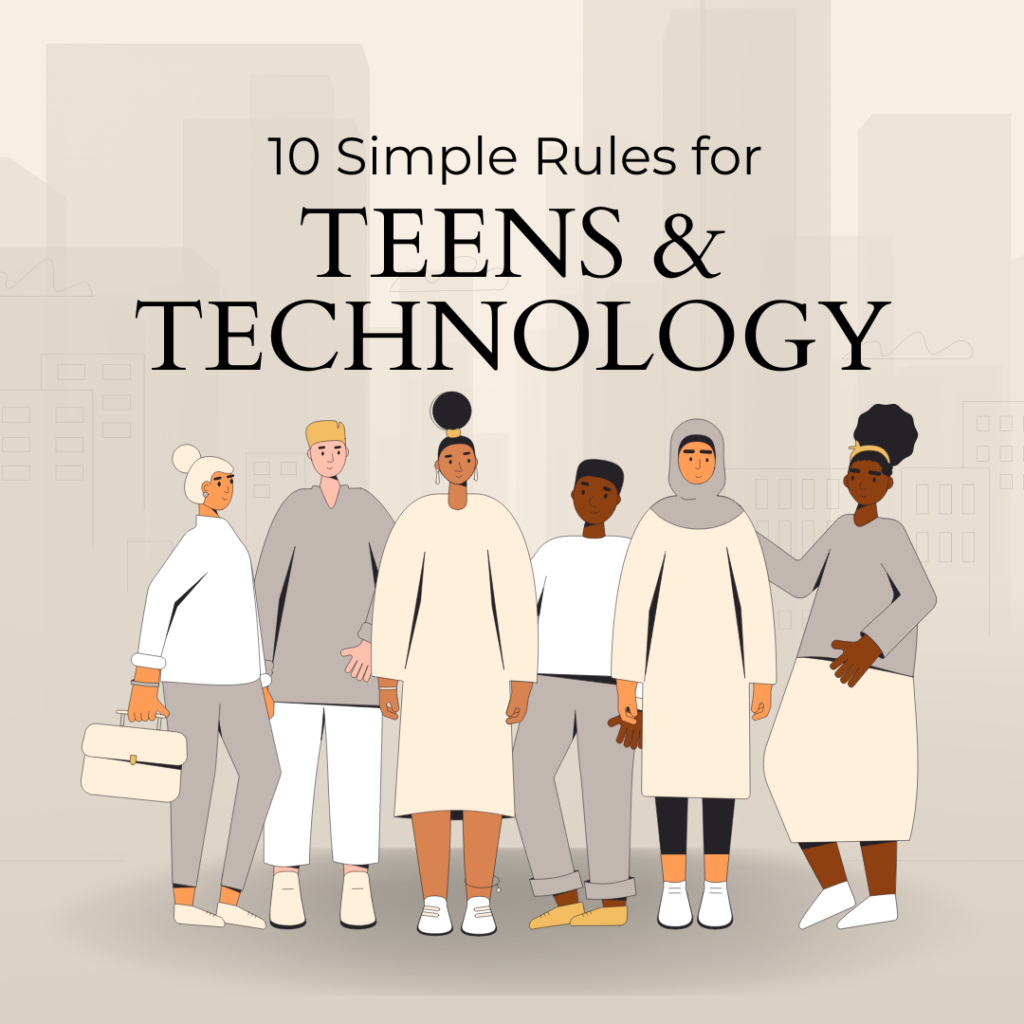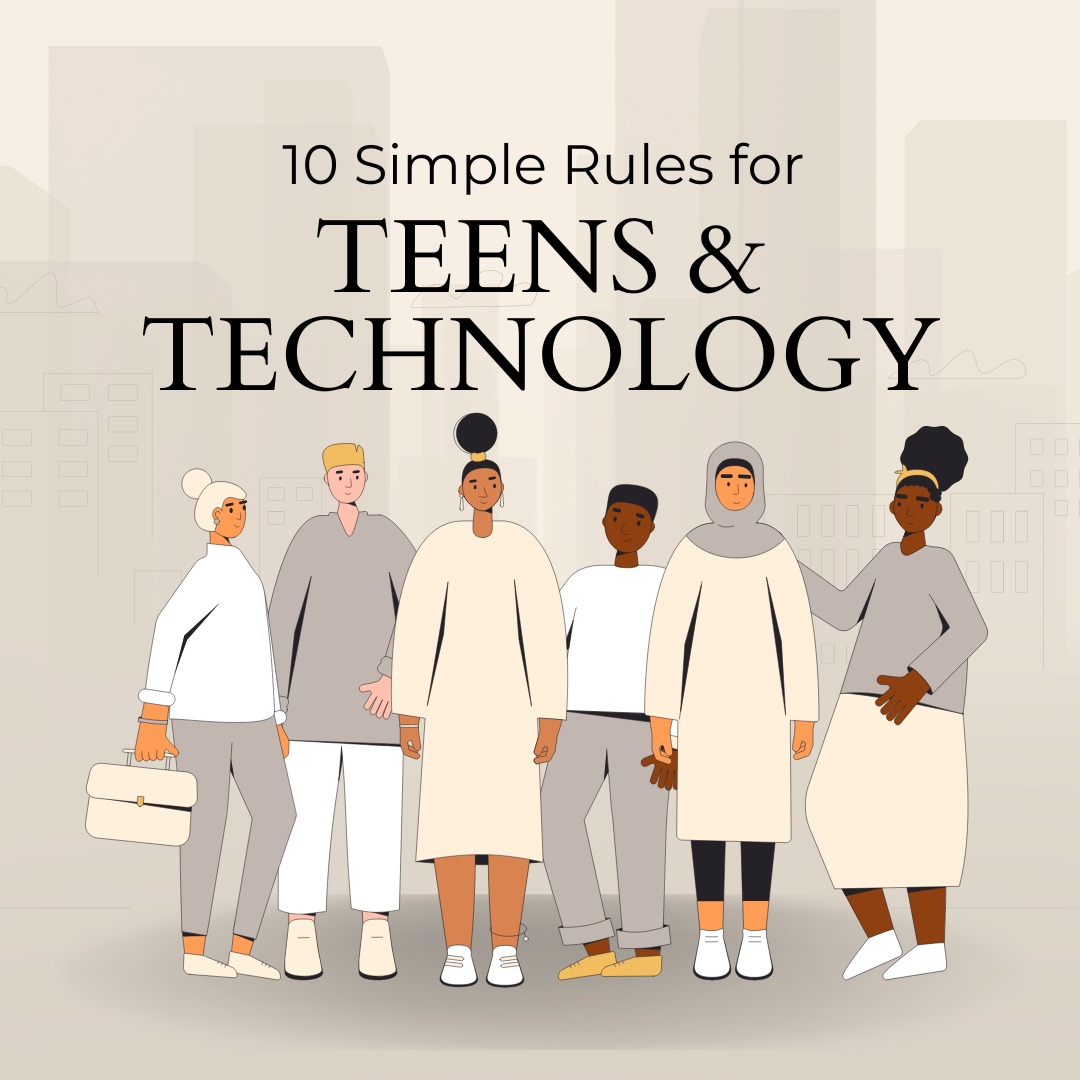
When parenting teenagers, discussions about rules can be a daily, and sometimes heated, conversation. One area that is more impactful than anything you could set limits on is technology. Your teen’s relationship with tech should be carefully curated and maintained. Here, I outline my simple rules for teens and technology.
Your teenager has grown up right alongside the internet. For as long as they have known, information is quickly and easily accessible. They could not imagine a time when to get information, you had to drive to the library, search the card catalog, comb the aisles for the book, and then read about the topic.
Understanding Your Teen’s World
Even recognizing that you and your teen have a different relationship with tech is a good place to start. While I advocate respecting your teens’ online lives, a parent’s decision is final. If I’m paying for your tech, I own it. We can discuss the rules, but like it or not, it is my decision as the parent. I will always prioritize my children’s safety over their satisfaction.
Lead by Example
That old adage, “Do as I say and not as I do,” is a recipe for disaster with teens. Take a hard look at how you model a relationship with technology. Are you frequently on your phone or laptop during family time? Do you monitor your screen time usage data?
A parent’s use of technology is different from a teen’s. It isn’t just recreational. Parents shop for food, pay bills, shop online, and conduct business from our devices. These are essentials; in comparison, you wouldn’t factor in time spent doing online school work as counting toward their screen time. However, it is pertinent to note that they spend more time in front of a screen than they may even realize.
Need some guidance on how to protect your child online? Download our Tools & Tips to Keep Your Kids Safe Online User Guide.
10 Simple Rules for Teens and Technology:
- Privacy:
Once you allow your child to enter the social media world, start them on a private account. This type of account ensures no one can follow or friend them without permission. Private accounts keep your teen’s content safe from anyone they don’t know. Public accounts can go viral from getting lots of likes and comments, but they leave your teen vulnerable to inappropriate and hurtful behavior from complete strangers.
If your teen has aspirations of being recruited for college sports or to be in the public eye as a performer or influencer, discuss a timeline for creating a public social media account specifically for this purpose. Set guidelines as to what type of content (and information about themselves) you are comfortable with them sharing.
- Time Limits:
You can use parental controls to set time limits on the phone and specific apps. Parental controls with time limits give the parent some backup. Instead of watching the clock or setting a timer, use the built-in parental controls to cut your child off when they’ve met their daily limit. You can set different hourly amounts for days of the week or by app.
- Phone’s down, Heads up:
No phones while driving. You should definitely model this rule for your children—using your phone while driving is dangerous. Teach your teen to use “do not disturb” mode or silence their phone while driving.
- Family Time is Tech-free:
Family time needs to be a non-electronics time. For my family, dinner is a priority. Phones and other electronics are not allowed at the table when we sit down to a meal together. This practice encourages real, personal interaction. I expand this rule to restaurants as well. Teens will learn proper dinner etiquette when phones are away, a valuable social skill for life.
- Be a Skeptic:
Although this is more of an important lesson than a rule, we still need to insist that they question the videos, images, and comments they see online. Videos and images can easily be manipulated, so teach your teens to question what they see.
- Embrace Boredom:
Many people use their devices during small moments like standing in line at the grocery store, waiting at the doctor’s office, or even showering. These moments are great opportunities for boredom. If necessity is the mother of invention, boredom is the father of creativity. Don’t pull your phone out at every opportunity to disengage with society. Model this for your children and talk with them. Some of my most fun moments with my kids came from waiting in line and trying to keep them entertained.
- Parental Engagement:
I insist on following my kids’ social media accounts. Two things happen when you do this:
- Your teen knows that everything they post, you can or will see and
- You learn the app they are using and first-hand experience the type of content and framework your child is interacting with.
8. Responsibilities First:
Whether homework, chores, or helping out around the house, instilling this rule teaches your teen how to prioritize their responsibilities.
9. Powerdown Before Sleep:
Sleep experts suggest an end to screen time 2 to 3 hours before bed. However, in the reality of an American teenager’s life, school, work, sports, and homework take up much of their time. Three hours before bed is when they may finally sit down to relax to use their devices. Use your discretion, but creating downtime and not falling asleep with the phone in their hand is the bare minimum here.
10. Respectful online behavior:
Talk to your teens about your expectations for appropriate social media, texting, and online behavior. Ensure they know people may send them unsolicited, inappropriate pictures and information.
I expect two things from my children in this area:
- Don’t send or post anything that you wouldn’t want me to see/read and
- If you receive something that makes you uncomfortable, tell me, and we can discuss what to do.
Bonus: Prioritize off-screen hobbies (IRL)
Get your teen involved IRL (in real life). Sign them up for whatever in-person activities interest them. They aren’t on a screen when playing a sport, taking an art class, or practicing martial arts. And if you find your teen gaming with a group of friends or snapping a group chat, encourage them to invite those friends over to the house or plan an event together instead. Sometimes, a small suggestion can spark a fun night!
Off-screen popular activities for teens include:
- Part-time job
- School or club sports
- Working out
- Martial arts
- Volunteer work
- Art classes
- Music & Theatre performance
Warning signs of too much screen time:
Impose limits to reduce your child’s screen time if they are experiencing any of these symptoms:
- Emotional Dysregulation: crying fits, bouts of depression, anxiety, panic attacks and avoidance of school or social events are all benefitted by reduced screen time.
- Disrupted Sleep: difficulty falling asleep, or waking up in the middle of the night could all be linked to screen time and blue light exposure.
- Behavioral problems: video games in particular are linked to difficulty maintaining focus and regulating emotions.
- Poor Academic Performance: compounded by a lack of sleep and difficulty focusing, academic performance will decline as these other symptoms increase.
Lastly, give yourself a break.
While these rules might be ideal, you have to make them work for you and your family realistically. If you are reading this and trying to implement rules like these in your home, pat yourself on the back for trying. Trying is a parent’s full-time job and the only measure of a good parent.

